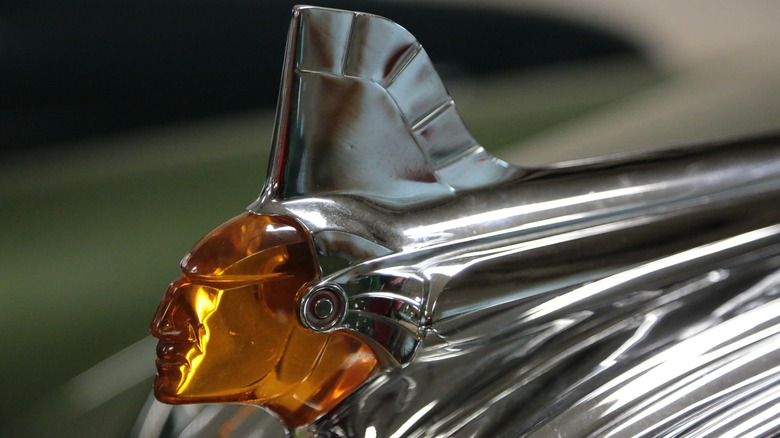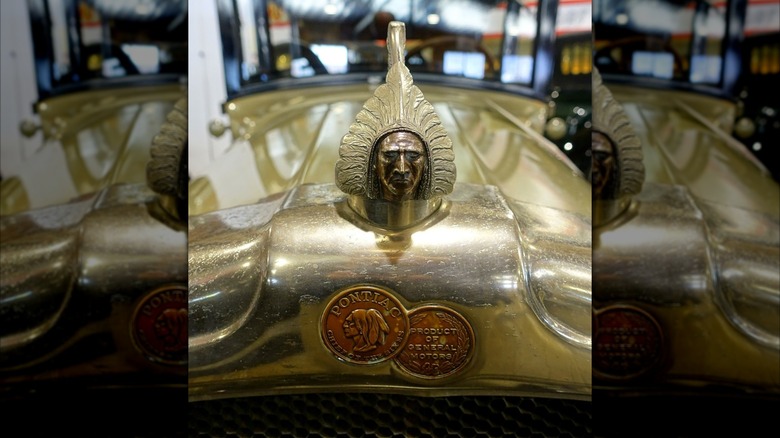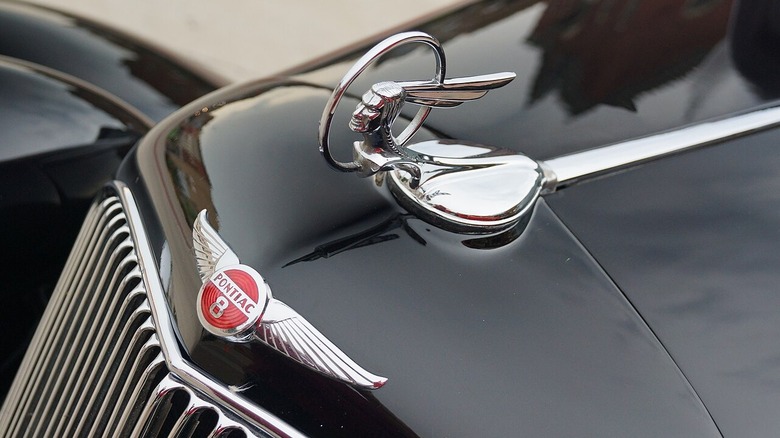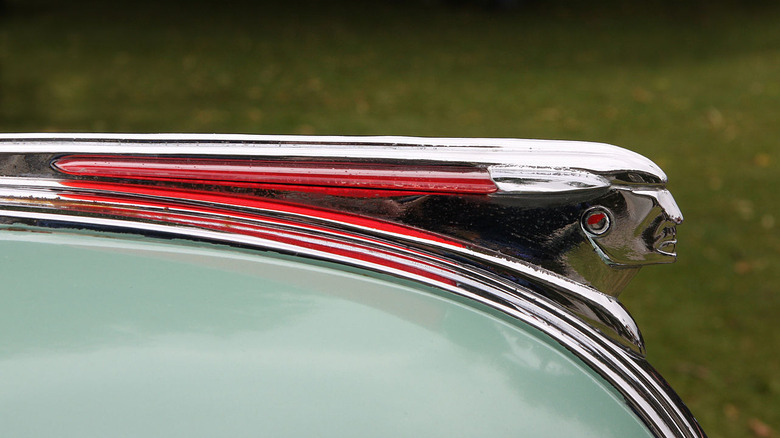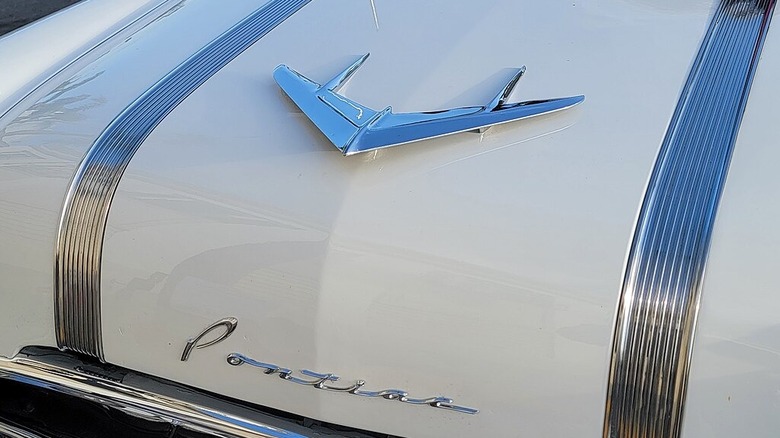4 Of Pontiac's Most Iconic Hood Ornaments
Hood ornaments have mostly gone the way of the dodo bird. Part and parcel of a bygone age, they jutted proudly off an automobile's front and cut through the air like the carved figureheads on the bows of ancient sailing vessels. And like those wooden sculptures, hood ornaments were works of art. They not only represented the automaker's brand but became status symbols for the rich and famous. What's more, they had a very practical purpose.
Back when cars were still in their infancy, many were plagued by overheating issues. Early radiator caps stuck up above the hood, so car designers began incorporating a "car mascot" (a term that morphed into hood ornament) to make them more stylish and appealing. They also came with thermometers called MotoMeters that screwed into the radiator cap so the owner could quickly and easily tell how hot the engine was. Over time, technology eliminated that need, and is but one of many reasons why hood ornaments became obsolete.
The first Pontiac rolled off the production floor in 1926, powered by a 3.0L six-cylinder engine that produced 40 horsepower. Pontiac was developed as a niche line of cars to accompany the more expensive Oakland brand, which had debuted in 1907 and was bought by General Motors in 1909. Pontiac was so successful that it replaced Oakland on the corporate pricing ladder in 1932. The last Pontiac ever was made in 2010, but along the way the brand produced several memorable hood ornaments.
1926: Chief Pontiac with a full feathered headdress
Pontiac vehicles were first built in Pontiac, Michigan, both of them named after a chief of the Ottawa Native American tribe. So the history and meaning behind the Chief Pontiac logo and hood ornament were important to the automaker.
Chief Pontiac, also known as Obwandiyag, lived from around 1720 until 1769 and was an ally to the French, helping them fight against the British during the French and Indian War. He brought together six tribes to try pushing the British out, leading a six-month siege against their forces at Fort Detroit – which would later become known as Motor City, home of the U.S. automotive industry. Due to his ability to organize a loose confederacy of Native American tribes, he's often referred to as "Chief of the Sixes."
Pontiac, the company, used the famous real-life war chief as the inspiration for over 40 different mascots and hood ornaments between 1926 and 1955, giving it the distinction of using the same symbol longer than any other carmaker.
When the first-ever Pontiac car came out in 1926, it featured Chief Pontiac's full head, complete with a feathered headdress. The company also made a coin with the chief's head in the middle, the name "Pontiac" above and "Chief of the Sixes" below. The back side of each coin reads "Product of General Motors."
1930s: Chief Pontiac's head sat inside a ring
Starting in the early 1930s, several variations of the chief-head ornament appeared. In 1934, however, Pontiac decided to feature the whole body of an Indian maiden lunging forward, available on the Deluxe version of the aptly named V8-powered Pontiac Eight line of vehicles.
When radiators started getting placed inside the engine compartment in the mid-1930s, caps placed on top of the hood began to disappear. However, auto designers who wanted to carry on their creativity began crafting "hood ornaments." This is when one of the five variations of Chief Pontiac's head in a ring ornaments began to appear. The one shown above features the vhief's stylized head with three feathers trailing behind in such a way as to elicit the idea of speed. This was carried back through a strip of chrome that ran off the back of the cap, up the middle of the hood towards the windshield.
Most of Pontiac's early hood ornaments resulted from work spearheaded by Harley J. Earl, GM's renowned designer, who believed every aspect of the car was integral to the vehicle's overall aesthetic — including the hood ornament. Earl's General Motors Styling section, later called the Art and Color Section, had become the automobile industry's first formalized styling section in 1928.
Late 1930s-early '40s: Chief Pontiac was streamlined
During the late 1930s and early 1940s, the imagery and iconography surrounding hood ornaments changed as technology evolved. Nothing was more indicative of the times than locomotives, particularly epitomized by sleek, art deco-stylized Streamliners.
Pontiac made dozens of "streamliner" hood ornaments that looked like trains, most with Chief Pontiac's head at the forefront, followed by a sleek piece of metal that shot back from the front and looked very much like a speeding train. Many were inset with clear, red, or amber-colored plastic to highlight certain parts of the ornament (mostly Pontiac's visage as the "head of the train"). Some of these could be made to light up.
This train motif lasted through much of the '40s, with one of the more iconic hood ornaments (shown above) appearing on virtually every model in 1948, including the Streamliner, Silver Streak, and Torpedo (one of four forgotten Pontiac models that deserve more recognition). The long, sleek, train-like ornament stretched back for days and sat atop a wider strip of chrome that ran up the hood to the windshield, resembling train tracks and further establishing that sense of graceful speed.
1950s: Pontiac spread its wings and flew away from its mascot
As the 1940s gave way to the '50s, the post-World War II technology explosion made trains a thing of the past. Carmakers wanted their vehicles' ornamentationto reflect the age of airplanes. Starting in 1950, a set of full-fledged plane wings began to appear.
In total, six different "flying" chief designs were made. The Society for Commercial Archaeology even quotes one Pontiac designer as saying, "We liked jet airplanes, we liked flashiness, we liked power." Most looked like the "train" ornaments with Chief Pontiac's head, but slapped with a pair of stylized wings. Other versions had the wings protruding skyward from his head. However, Chief Pontiac's run as Pontiac's car mascot ended in 1954, and the following year brought hood ornaments that looked like a large passenger jet (as shown above on the 1956 Star Chief).
Something else may have helped make Chief Pontiac obsolete. In 1954, President Dwight D. Eisenhower signed a bill that gave Wisconsin's Menominee tribe autonomy. These new freedoms allowed Native Americans to escape the reservation and interact with the general population in a way never before seen, making people look at them differently. In 1956, the 84th Congress passed legislation doing the same for the Ottawa tribe, which Chief Pontiac had led.
